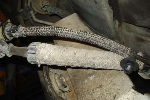scoodidabop
Well-Known Member
- Joined
- November 16, 2012
- Messages
- 139
- Reaction score
- 0
- City, State
- Houston TX
- Year, Model & Trim Level
- 1993 Explorer
So here's what I'm thinking about using:
http://www.intellitronix.com/5-gauge-panel.html
The unit comes with replacement sensors based on the make and year of your vehicle to use with the digital panel. My concern is that some of the OEM sensors (oil, voltage etc...) serve more functions than just delivering a reading to the gauge cluster. Does the temp sensor reading help the computer adjust water pump flow and turn on the condenser fan? If all these sensors serve additional functions I wonder if I can simply splice into the wires on some of them and leave the original sensor in place without impairing any operational functionality.
Why digital? Well I have to fabricate a custom dashboard to use in my Jurassic Park Explorer and the original gauge cluster is a bit too bulky to build in to the custom dash. While hi-beam and turn signals are built into the Intellitronix cluster I can sneak the "check engine" other indicators into other sections of the dash with some creative placement.
http://www.intellitronix.com/5-gauge-panel.html
The unit comes with replacement sensors based on the make and year of your vehicle to use with the digital panel. My concern is that some of the OEM sensors (oil, voltage etc...) serve more functions than just delivering a reading to the gauge cluster. Does the temp sensor reading help the computer adjust water pump flow and turn on the condenser fan? If all these sensors serve additional functions I wonder if I can simply splice into the wires on some of them and leave the original sensor in place without impairing any operational functionality.
Why digital? Well I have to fabricate a custom dashboard to use in my Jurassic Park Explorer and the original gauge cluster is a bit too bulky to build in to the custom dash. While hi-beam and turn signals are built into the Intellitronix cluster I can sneak the "check engine" other indicators into other sections of the dash with some creative placement.










